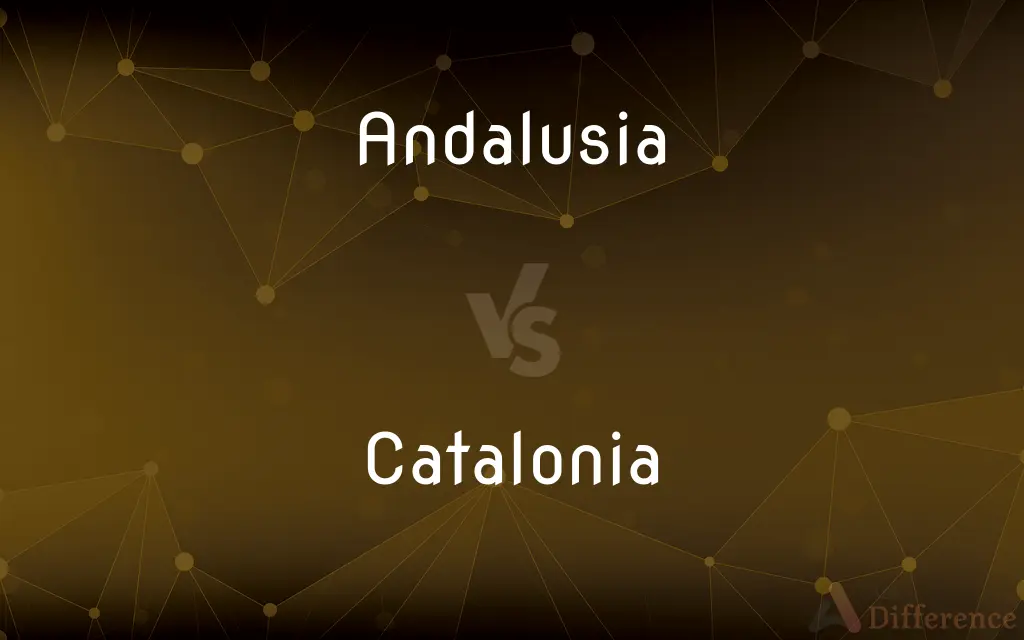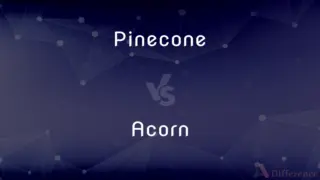Andalusia vs. Catalonia — What's the Difference?
Edited by Tayyaba Rehman — By Urooj Arif — Updated on April 6, 2024
Andalusia is a culturally rich region in southern Spain known for flamenco and Moorish architecture, whereas Catalonia, in the northeast, is recognized for its distinct language, Catalan, and economic prowess.

Difference Between Andalusia and Catalonia
Table of Contents
ADVERTISEMENT
Key Differences
Andalusia, located in southern Spain, is celebrated for its historical legacy, featuring a blend of Moorish and Christian influences, evident in its architecture, such as the Alhambra in Granada. Catalonia, on the other hand, boasts a strong identity marked by its own language and traditions, with Barcelona's modernist architecture by Antoni Gaudí as a highlight.
The economy of Andalusia traditionally relies on agriculture, tourism, and services, with a focus on its natural landscapes and cultural festivals like the Feria de Abril. Catalonia, however, stands as one of Spain's most economically dynamic regions, with a robust industry, technology sector, and tourism, driven by its capital, Barcelona, and the Costa Brava.
Andalusia's cuisine is known for its olive oil, gazpacho, and fried fish, reflecting its agricultural heritage and Mediterranean climate. Catalonia's culinary scene is diverse, featuring dishes like pa amb tomàquet (bread with tomato) and a strong emphasis on seafood, showcasing its coastal influence and innovative gastronomy.
Festivals and traditions in Andalusia, such as flamenco music and dance, bullfighting, and religious processions, underscore its historical depth and cultural richness. Catalonia celebrates its unique identity through festivals like La Diada (National Day of Catalonia) and Sant Jordi, blending cultural, literary, and historical significance.
Language plays a crucial role in distinguishing Catalonia from Andalusia. While Andalusian Spanish has its own dialectal features, Catalonia's promotion of the Catalan language in education, media, and public life highlights its efforts to preserve and foster its linguistic heritage.
ADVERTISEMENT
Comparison Chart
Location
Southern Spain
Northeastern Spain
Cultural Highlights
Flamenco, Moorish architecture
Catalan language, Modernist architecture
Economy
Agriculture, tourism, services
Industry, technology, tourism
Cuisine
Olive oil, gazpacho, fried fish
Pa amb tomàquet, seafood
Festivals
Feria de Abril, religious processions
La Diada, Sant Jordi
Language
Andalusian Spanish (dialect)
Catalan (distinct language)
Compare with Definitions
Andalusia
Andalusia is a region in southern Spain known for its flamenco music and dance.
The streets of Seville come alive with flamenco during the Feria de Abril.
Catalonia
Catalonia is an autonomous community in northeastern Spain with its own language.
In Catalonia, both Spanish and Catalan are spoken fluently by the population.
Andalusia
Andalusia’s cuisine emphasizes olive oil and fried dishes.
Andalusian gazpacho is a refreshing, cold soup perfect for hot summers.
Catalonia
Known for Barcelona's modernist architecture.
The Sagrada Familia, designed by Antoni Gaudí, is an iconic symbol of Catalonia.
Andalusia
Its economy is significantly bolstered by tourism.
Andalusia attracts tourists with its cultural festivals and historical sites.
Catalonia
Catalonia has a strong push for independence.
The debate over Catalonia’s independence from Spain has intensified in recent years.
Andalusia
It features a rich Moorish heritage visible in its architecture.
The Alhambra in Granada is a prime example of Moorish architecture in Andalusia.
Catalonia
Its cuisine features a mix of seafood and innovative dishes.
Pa amb tomàquet, simple yet beloved, symbolizes Catalan culinary simplicity.
Andalusia
The region has a distinct Andalusian Spanish dialect.
Andalusian Spanish is known for its characteristic pronunciation.
Catalonia
Economically, it is one of Spain's most prosperous regions.
Catalonia's diverse economy includes a significant contribution from the tech industry.
Andalusia
Andalusia (UK: , US: ; Spanish: Andalucía [andaluˈθi.a]) is the southernmost autonomous community in Peninsular Spain. It is the most populous and the second largest autonomous community in the country.
Catalonia
Catalonia (; Catalan: Catalunya [kətəˈluɲə, kataˈluɲa]; Aranese Occitan: Catalonha [kataˈluɲa]; Spanish: Cataluña [kataˈluɲa]) is an autonomous community in the northeastern corner of Spain, designated as a nationality by its Statute of Autonomy.Catalonia consists of four provinces: Barcelona, Girona, Lleida, and Tarragona. The capital and largest city, Barcelona is the second-most populated municipality in Spain and the fifth-most populous urban area in the European Union.
Andalusia
A region in southern Spain on the Atlantic and the Mediterranean; formerly a center of Moorish civilization
Catalonia
A geographical and administrative region of northeastern Spain.
Catalonia
A region of northeastern Spain
Common Curiosities
How do the cuisines of Andalusia and Catalonia differ?
Andalusian cuisine is known for its use of olive oil and fried dishes, while Catalan cuisine emphasizes seafood and innovative dishes.
What are significant cultural festivals in Andalusia and Catalonia?
Andalusia is famous for the Feria de Abril and religious processions, while Catalonia celebrates La Diada and Sant Jordi.
What role does language play in Catalonia's identity?
The Catalan language plays a central role in Catalonia's cultural and political identity, with efforts to promote its use in public life.
How does the economy of Andalusia compare to that of Catalonia?
Andalusia's economy is largely based on tourism and agriculture, while Catalonia boasts a more diversified economy with strong industrial, tech, and tourism sectors.
What is Andalusia known for?
Andalusia is renowned for its flamenco culture, Moorish architecture, and vibrant festivals.
What distinguishes Catalonia's identity?
Catalonia's distinct identity is marked by its own language, Catalan, modernist architecture, and a strong economic base.
What is a traditional dish from Catalonia?
Pa amb tomàquet, bread rubbed with tomato and olive oil, is a simple, traditional Catalan dish.
How does the political landscape differ between Andalusia and Catalonia?
While Andalusia is known for its cultural heritage, Catalonia has a notable political landscape characterized by movements for greater autonomy or independence.
What architectural styles are prevalent in Catalonia?
Catalonia is noted for its Roman, medieval, and especially modernist architecture, exemplified by the works of Antoni Gaudí.
What is a traditional dish from Andalusia?
A traditional dish from Andalusia is gazpacho, a cold tomato-based soup.
Can you describe a major architectural highlight of Andalusia?
The Alhambra in Granada, with its exquisite Islamic architecture, is a major highlight of Andalusia.
What historical influences are visible in Andalusia?
Andalusia's history is deeply influenced by Moorish and Christian civilizations, evident in its architecture and festivals.
How do festivals reflect the culture of Andalusia and Catalonia?
Festivals in Andalusia, like flamenco and bullfighting, reflect its traditional Spanish culture, while Catalonia's festivals emphasize its unique regional identity and history.
What is the significance of the Catalan language in Catalonia's culture?
The Catalan language is a cornerstone of Catalonia's cultural identity, essential for its literature, media, and public signage.
How do Andalusia and Catalonia contribute to Spain's tourism?
Both regions are key tourist destinations: Andalusia for its historical and cultural allure, and Catalonia for its architectural marvels and vibrant city life.
Share Your Discovery

Previous Comparison
Sleuth vs. Tec
Next Comparison
Pinecone vs. AcornAuthor Spotlight
Written by
Urooj ArifUrooj is a skilled content writer at Ask Difference, known for her exceptional ability to simplify complex topics into engaging and informative content. With a passion for research and a flair for clear, concise writing, she consistently delivers articles that resonate with our diverse audience.
Edited by
Tayyaba RehmanTayyaba Rehman is a distinguished writer, currently serving as a primary contributor to askdifference.com. As a researcher in semantics and etymology, Tayyaba's passion for the complexity of languages and their distinctions has found a perfect home on the platform. Tayyaba delves into the intricacies of language, distinguishing between commonly confused words and phrases, thereby providing clarity for readers worldwide.














































